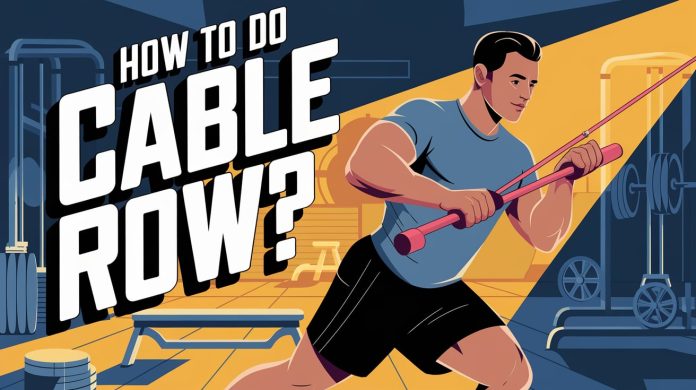The Seated Cable Row is an excellent exercise for strengthening your back and improving overall posture. It’s not just for seasoned gym-goers—whether you’re a beginner or more experienced, it’s accessible and can be tailored to your fitness level.
How to Do Seated Cable Row?
- Positioning: Sit on the bench of the cable machine with your feet flat on the foot pads. Keep your knees slightly bent and your back straight. You want to maintain an upright posture to avoid any strain.
- Grip: Reach forward to grab the handle (usually a V-grip or a wide bar depending on your focus). Ensure your arms are fully extended while maintaining a straight back.
- Engage Core and Pull: Keep your core tight and pull the handle toward your torso. As you do this, think about squeezing your shoulder blades together. This will engage your rhomboids and lats. The motion should stop when the handle is near your lower chest or upper abdomen.
- Return Slowly: Extend your arms back to the starting position while controlling the weight to maximize the tension in your back muscles.
- Repetition: Perform 3-4 sets of 8-12 reps, adjusting the weight as you progress.
What Are the Benefits of Seated Cable Row?
- Builds Back Muscle: The Seated Cable Row specifically targets the rhomboids, latissimus dorsi (lats), and traps, contributing to a stronger and more muscular back.
- Improves Posture: Strengthening the muscles between your shoulder blades helps improve posture and alleviate back pain.
- Enhances Grip Strength: This exercise also challenges your forearms and grip strength, as you’ll need to hold onto the handle throughout the movement.
- Shoulder Health: Proper form with scapular retraction (pulling your shoulder blades back and down) helps maintain shoulder health by reducing the risk of injury.
What Are the Risks of Seated Cable Row?
- Poor Form: Using improper form can lead to shoulder or back strain. It’s important to focus on controlled movements rather than rushing through the reps.
- Overloading: Lifting too much weight without mastering the technique can stress your lower back or cause muscle imbalances.
- Excessive Swinging: Avoid swinging your body to move the weight; this reduces the effectiveness of the exercise and increases the risk of injury.
Who Should Do Seated Cable Row?
- Beginners: This is an excellent starting exercise for those new to strength training, as it helps you develop muscle control in your back.
- Intermediate and Advanced Lifters: For those with more experience, you can use the Seated Cable Row to increase load and target specific back muscles with variations.

Who Should Not Do Seated Cable Row?
- Those with Lower Back Issues: If you suffer from chronic lower back pain, be cautious with this movement. Consult a professional if unsure.
- Shoulder Injuries: If you have any existing shoulder injuries, be mindful of your form and avoid excessive weight.
Tips
- Control the Movement: Avoid jerking the weight or using momentum. The slower and more controlled the movement, the more you’ll engage your muscles.
- Mind the Grip: Try alternating between a V-grip bar and a wide bar to target different parts of your back.
- Use a Mirror: Keep an eye on your posture to ensure you aren’t rounding your back during the movement.
Variations of Seated Cable Row
- Single-Arm Row: If you’re looking to address muscle imbalances, try using one arm at a time. This allows you to focus more on each side.
- Wide-Grip Row: A wider grip will put more emphasis on your upper back and shoulders.
- Face Pull: Use a rope attachment for a face pull variation, which targets the upper back and rear deltoids
References
- How to Do a Seated Cable Row: Proper Form & Benefits
- How To Do Seated Cable Rows
- How to Do the Seated Cable Row Exercise to Build Back Muscle
- Guide to Seated Cable Row: Techniques and More
Discover a wealth of information on our blog, where we delve into the world of sports life, provide comprehensive guides on exercises, share delicious and nutritious fit recipes, and explore the intricacies of muscle anatomy. Whether you’re a fitness enthusiast or just starting your journey, our blog offers valuable insights and tips to help you achieve your health and fitness goals.
Thanks for reading. Stay healthy and stay fit!



